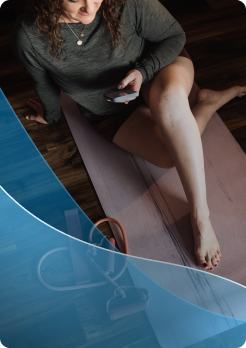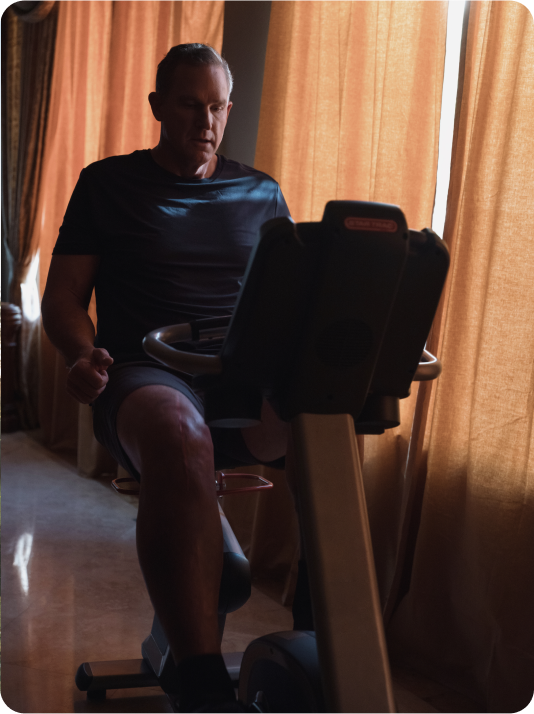RECOVERY & REHAB
Okay, that
was fun (not)
Getting your new knee is a major milestone. Now it’s time to focus on recovery
Hint: you've got this!

"One small step beats standing still"
Zimmer Biomet Chief Movement Officer


A real Personalized Knee® experience
It gets better, right?
Yes, it gets better
Stick to the plan
Your doctor made that plan for a reason—and no, googling doesn’t count as a second opinion. Contact your doctor immediately if you notice excessive swelling, fever, chills, wound drainage, or increasing leg or calf pain—these could be signs of an infection or blood clot.
Stay on schedule
Set reminders to take pain medication as directed.
Keep it cool
Use ice packs to reduce swelling and keep things comfortable.
Keep it circulating
While resting, try ankle pumps to improve blood flow.
Maintain clean incision sites
Keep it clean and dry. Your care team will provide dressing instructions before you leave. Choose loose, comfortable clothing to avoid irritation. Home health aides or in-home physical therapists can make a big difference for caring for your incision.
Follow bathing instructions
Waterproof dressings are often shower-friendly, but staples or bandages may require waiting. When you need to wash, showers are recommended to help keep your incision dry. Talk to your doctor about when it’s safe to shower.
Sleep isn’t just for beauty—it’s for healing, too
It’s important to get at least 8 hours of sleep per night during the recovery period (a well-rested body is a healing machine!), so make sure your bed is properly set up.
Check first
Ask your doctor what sleeping position is best for your individual condition.
For extra support
For extra support, use a foam wedge to elevate your leg and support your knee, or a firm pillow from your knee to your calf.
No pillow? No problem
If elevating your leg and supporting your knee feels good, ask your doctor whether it’s okay to place a rolled-up towel under your ankle. They may recommend avoiding anything under your knee to help keep your leg straight while you sleep.
Pain and swelling after surgery
Pain is a normal part of recovery. It can be managed with medication, icing, and elevation. Think of it as your joint’s dramatic phase—it gets better.
Narcotic medications
If you’re prescribed opioids, they can help with pain after surgery—but they’re not a long-term plan. Use them exactly as your doctor tells you, and start dialing back as soon as you feel better. Still hurting after a few days? That’s your cue to check in with your doctor, not tough it out.
Different types of swelling may occur after knee replacement surgery
Moderate to severe swelling may appear during the first few days or weeks after surgery, while mild to moderate swelling can continue for up to six months as part of the normal healing process.
How to reduce swelling
To help reduce swelling, your doctor may recommend slightly elevating your leg, applying ice to the affected area, and wearing compression stockings. These simple steps can support healing and improve comfort during recovery.
Tell your doctor if you experience new or severe swelling. This may be a warning sign of a blood clot.
This is a comeback, not a fast-forward, but you'll get there
There’s no set timeline for recovery—it’s different for everyone. Some people find their rhythm in 3 to 6 weeks, while others take longer to fully get back to what they love.
Your doctor and physical therapist will craft a plan that’s built around your goals and progress, helping you move forward one step at a time.
First steps: Returning to activity
Recovery starts with one step—literally. With support, many patients are up and walking shortly after surgery. These first small steps pave the way for recovery.
Take it 1 day at a time
Recovery isn’t a sprint; it’s a marathon. Some days might feel tougher than others, and that’s okay. Celebrate the small wins, like getting out of bed or taking a few steps.
Back to work
Whether you’re at a desk or on your feet all day, your timeline to return will depend on your recovery, progress, and your job. Your doctor will help you figure out when it’s safe to dive back in.
Hitting the road
Most patients feel ready between 4 to 6 weeks post-surgery to get behind the wheel, but your doctor will help decide the right time for you.
Active, not impactful
There are joint-friendly activities like swimming, walking, or cycling to keep things strong and smooth.*
*Ask your doctor what activities are right for you.
Recovery isn’t just physical. It’s mental, emotional, and maybe even a little funny
Hey, that new knee is looking good. This is the time to keep a positive mindset. Watch comedies, talk to a friend who makes you laugh—whatever keeps the vibes good while your knee does its thing
Here are some other tips to help you get the most out of your recovery period.
Find your people and swap helpful tips
Join local or online support groups to connect with others on their knee replacement journey. Sharing stories of recovery can make challenges feel more manageable.
Bookmark trusted healthcare websites for tips on pain management, wound care, and feel-good exercises.
Ask for help
Lean on family and friends for errands like grocery runs or prescription pick-ups. Most people are ready to help—you just need to ask!
Take some you time
Self-care matters! Take breaks when therapy feels hard or practice mindfulness exercises to help recharge and stay steady throughout your recovery.
Celebrate the little victories
Did you take a few steps today? High five! Did you manage to get a good night’s sleep? Heck yeah! Every little step forward is worth celebrating.
Keep your eyes on the prize
A positive mindset is like a secret weapon for healing. Picture yourself a few months from now, walking without pain.
Time to put in the work. Your knee isn't going into rehab by itself
Physical therapy and assistive devices
Physical therapy is one of the most important parts of your recovery. It typically begins the same day as your surgery with specific exercises to reduce swelling and improve range of motion, gradually progressing to restore strength and flexibility.
Setting recovery expectations
Knee replacement isn’t an instant fix. While you’ll likely notice pain relief, your new knee won’t feel “normal” immediately. It takes time to regain full mobility and strength, and some physical restrictions may be permanent.
Using a walker or cane
Your surgeon and physical therapist will determine which walking aids (such as canes, crutches, walkers, and handrails) you'll need after surgery and when it's safe to stop using them. Go at your own pace.
Take advantage of the mymobility® app
In addition to guidance from your physical therapist or exercises provided through the mymobility app, practicing simple movements like ankle pumps, knee extensions, heel slides, and hip abductions can help improve mobility in your new knee.

A real Personalized Knee® experience
